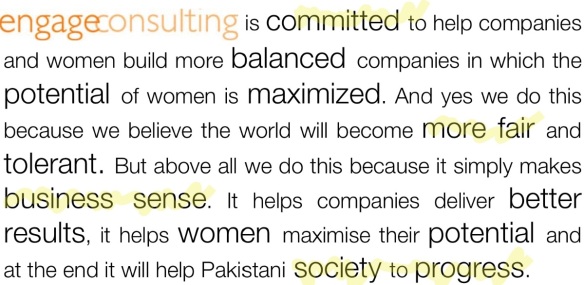 This is the last blog on my Women@Work special. Over the past weeks I shared with you a number of insights on the state of gender diversity in corporate Pakistan; what female employees want from their employers, how Pakistani companies are living up to their expectations and how they can create more female friendly workplaces. In my last edition, I focus on what women can do to succeed in the Pakistani workplace. Can’t wait? Find out now by reading our full report or watch our 4 minute summary presentation.
This is the last blog on my Women@Work special. Over the past weeks I shared with you a number of insights on the state of gender diversity in corporate Pakistan; what female employees want from their employers, how Pakistani companies are living up to their expectations and how they can create more female friendly workplaces. In my last edition, I focus on what women can do to succeed in the Pakistani workplace. Can’t wait? Find out now by reading our full report or watch our 4 minute summary presentation.
As part of our Women @ Work study we also interviewed 30+ successful female managers and executives across all participating companies. Although each story is different there were some striking similarities. Some highlights:
Family Support is the Cornerstone of a Female Career
 Almost all women mention that support from their spouse and family is the key to their success. Spouses have to be progressive enough not only to support them in their endeavors but also to make a larger than normal contribution to the household and in some cases take over looking after the kids to facilitate their wives to travel and fulfill the sometimes required long hours.
Almost all women mention that support from their spouse and family is the key to their success. Spouses have to be progressive enough not only to support them in their endeavors but also to make a larger than normal contribution to the household and in some cases take over looking after the kids to facilitate their wives to travel and fulfill the sometimes required long hours.

Mentors Help Navigate Tricky Waters
Every woman no matter how successful she has been has landed in situations that needed careful maneuvering. Mentors, either from within the company or sometimes from previous companies have been instrumental in managing these situations. All successful women interviewed could identify a person who they regard as a mentor and who have helped them through difficult career patches.
 Building a Network
Building a Network
Being able to build a strong network in the company of both female and male colleagues has paid successful women strong dividends. Networks are there to support, ask for advice, help to step in and create a larger support structure for a person to succeed. Successful female executives have stressed the importance of not letting the man run the “old boys’ network” but to go out and build a strong network in the company.
Focus on Delivering Results
The most striking discovery was that all these successful women we interviewed condemned women who conformed to pre- conceived notions of a man’s view of a woman! Pakistani society cultivates strong opinions and biases towards working women and it is only your own performance that can change these views. Women should not be distracted by difficulties and should be willing to get out of their comfort zones and work in situations and jobs that make them uncomfortable and blow off everyone with their superb performance. Because at the end of the day it is only your performance that matters, not gender!
Women @ Work: What’s Next
Having completed the first ever gender diversity study in Pakistan you might be thinking ‘what next’? We would love to hear your ideas as this is what we plan to do:
- We want to support companies in creating female friendly workplaces,
- Support women in maximizing their potential, and
- Understand drivers of gender diversity in more detail.
We do so because we believe that the world will become more tolerant and fair if more women have executive and leadership positions. But more importantly we do this because it just makes business sense! How so?? Read our full W@W report and find out! Or watch our 4 minute summary presentation.
– Paul Keijzer









